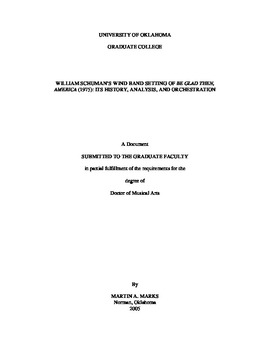| dc.contributor.advisor | Wakefield, William K., | en_US |
| dc.contributor.author | Marks, Martin A. | en_US |
| dc.date.accessioned | 2013-08-16T12:19:53Z | |
| dc.date.available | 2013-08-16T12:19:53Z | |
| dc.date.issued | 2005 | en_US |
| dc.identifier.uri | https://hdl.handle.net/11244/903 | |
| dc.description.abstract | This document seeks to reconcile Be Glad Then, America to the wind band community for consideration in repertoire, particularly in combination with When Jesus Wept and Chester. It contains errata lists for the score and individual parts, and suggestions for alternative scoring to moderate the use of high register in the wind sections. Biographies of Schuman and Billings are provided, along with a history of New England Triptych and Be Glad Then, America. Further, the document includes an analysis of the work, illustrated with score excerpts that correlate its themes to Mourn, Mourn. | en_US |
| dc.description.abstract | The historical background, analysis, errata lists, and alternative scoring suggestions provide tools to assist any conductor who wishes to program Be Glad Then, America. | en_US |
| dc.description.abstract | The restless energy and exuberant melodies of the first movement made it an attractive repertory prospect for wind band conductors. While the initial response to the publication of Be Glad Then, America was enthusiastic, it was soon apparent that it was considerably less accessible compared to When Jesus Wept and Chester. The score and individual parts contained a large number of errors, and the upper ranges of the wind instruments were over-employed, affecting intonation, balance, and individual stamina. As a result, the piece is rarely programmed. | en_US |
| dc.description.abstract | Be Glad Then, America is the wind band setting of the first movement of William Schuman's New England Triptych, an orchestral work published in 1956. Its second and third movements, When Jesus Wept and Chester, were rewritten for band and published in 1957. Schuman published Be Glad Then, America nearly twenty years later at the request of band directors who wished to program all three movements of New England Triptych. | en_US |
| dc.description.abstract | New England Triptych was Schuman's tribute to composer William Billings. Like Billings, Schuman valued melody above all other compositional elements. The first movement was based on melodies from the Billings anthem Mourn, Mourn. New England Triptych tied together themes from selected Billings tunes, connecting each section with timpani and snare drum solos. | en_US |
| dc.format.extent | ix, 135 leaves : | en_US |
| dc.subject | Music. | en_US |
| dc.subject | Schuman, William, 1910- New England triptych. Be glad then, America. | en_US |
| dc.subject | Wind instrument music Analysis, appreciation. | en_US |
| dc.title | William Schuman's wind band setting of "Be Glad Then, America" (1975): Its history, analysis, and orchestration. | en_US |
| dc.type | Thesis | en_US |
| dc.thesis.degree | D.M.A. | en_US |
| dc.thesis.degreeDiscipline | School of Music | en_US |
| dc.note | Adviser: William K. Wakefield. | en_US |
| dc.note | Source: Dissertation Abstracts International, Volume: 66-05, Section: A, page: 1553. | en_US |
| ou.identifier | (UMI)AAI3176316 | en_US |
| ou.group | Weitzenhoffer Family College of Fine Arts::School of Music | |
